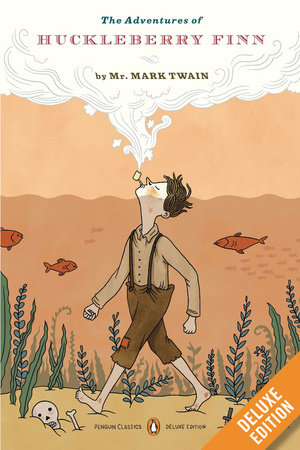The Adventures of Huckleberry Finn Reader’s Guide
By Mark Twain


INTRODUCTION
Arguably Mark Twain’s most famous novel—indeed, one of the greatest works of American literature—The Adventures of Huckleberry Finn brings together two people from the lower rungs of society, an ill-educated boy escaping an abusive father and a kind, strong man escaping slavery, and puts them on a raft going down the Mississippi River. The raft gives us the quintessential image of Huck Finn, but in fact much of the novel takes place on land, where the protagonists repeatedly find themselves having to escape from one bind or another. What began for Mark Twain as a sequel to his novel of American boyhood, The Adventures of Tom Sawyer, became over the years of its composition a much more complex work. Set in the late 1840s, Huck Finn is a post-Civil War realist novel that reads like a picaresque romantic adventure with colorful gothic trimmings and—despite the author’s “Notice” at the front of the book—a strong moral core. At its heart is the complicated, evolving relationship between Huck and Jim, a white boy and a black man, both of whom yearn for freedom from society’s strictures. By the time the novel appeared, slavery was in the past, but racism was not. It is impossible to know how his first readers understood his portrayals of his characters and especially of Huck’s dawning conscience, but readers today continue to ponder and debate Mark Twain’s “motive” and “moral.”
Mark Twain was born Samuel Langhorne Clemens in Florida, Missouri, in 1835, and died at Redding, Connecticut in 1910. In his person and in his pursuits he was a man of extraordinary contrasts. Although he left school at twelve when his father died, he was eventually awarded honorary degrees from Yale University, the University of Missouri, and Oxford University. His career encompassed such varied occupations as printer, Mississippi riverboat pilot, journalist, travel writer, and publisher. He made fortunes from his writing but toward the end of his life he had to resort to lecture tours to pay his debts. He was hot-tempered, profane, and sentimental—and also pessimistic, cynical, and tortured by self-doubt. His nostalgia helped produce some of his best books. He lives in American letters as a great artist, the writer whom William Dean Howells called “the Lincoln of our literature.”
Just for joining you’ll get personalized recommendations on your dashboard daily and features only for members.
Find Out More Join Now Sign In